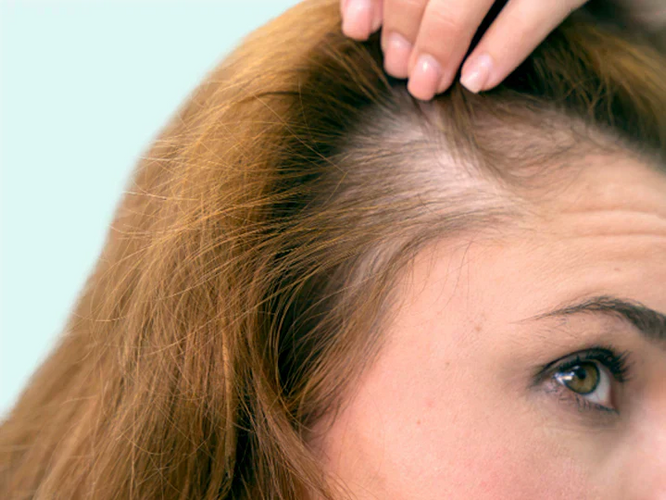Hair loss in women is a common problem. The causes range from hereditary factors to hormonal changes. In many cases it is temporary and harmless. In this article you will learn about the main causes and how to recognise them
What are common causes of hair loss in women?
The most common causes of hair loss in women can be divided into two main categories:
- Genetically determined progressive hair loss (androgenetic alopecia)
- Sudden hair loss (telogen effluvium), which can be caused by hormonal changes, but also by stress, illness, medication or contractive use or nutrient deficiencies. Some causes of hair loss affect both men and women, including genetics, poor nutrition, vitamin deficiencies and smoking.

Infographic: hair loss women explained
Genetic hair loss is common in both women and men. The key difference between the sexes lies in the occurrence of sudden hair loss due to hormonal fluctuations. For women, there are specific life stages when hair loss often becomes more noticeable. Some women experience this during pregnancy.
Some causes of hair loss affect both men and women, including genetics, poor nutrition, vitamin deficiencies and smoking. Curious how to counter these factors effectively? Our hair growth guide offers a complete overview and effective solutions.
Genetic hair loss in women explained
For many women, it comes as a shock: your hair gradually becomes thinner, especially on the top of your head near the parting or crown, and suddenly you notice more scalp showing in the mirror. You’re not alone. This is a hereditary form of hair loss that often starts slowly but can eventually have a major impact on your self-esteem.
The cause is a genetic sensitivity of the hair follicles to hormonal influences, with dihydrotestosterone (DHT), a breakdown product of testosterone, playing an important role. Although women produce only a fraction of the testosterone that men do, DHT can still have a major effect.
It shortens the hair's growth phase, causing hairs to become thinner, shorter, and eventually less visible, a process known as miniaturisation.
What many women don't realise is that genetic hair loss appears differently in women compared to men. Women rarely experience complete baldness or a receding hairline. Instead, there is gradual thinning around the parting and crown area.
The Ludwig Scale, a tool used to describe patterns of hair loss in women, shows three stages: from mild thinning to noticeable hair loss at the top of the head. However, the hairline usually remains unaffected.
Hormonal hair loss: causes explained
If you notice your hair becoming thinner or falling out more quickly than usual, hormones could be playing a role. Various hormonal changes throughout life can affect hair growth, from pregnancy to menopause, and even when starting or stopping birth control.
Below you can read which hormonal causes are at the root of hair loss in women.
Hair loss during menopause
During menopause, your hormone levels change significantly. In particular, oestrogen levels drop, disrupting the balance between oestrogen and androgens. As a result, hair can move into the resting phase more quickly and fall out sooner.
Many women notice that their hair becomes thinner during this period, especially at the top of the head or around the crown. While this is a natural process, it can have a major emotional impact.
Hair growth and hair loss around pregnancy
Hormonal hair loss is also inevitable after pregnancy. Some women find that their hair becomes thicker during pregnancy, only to be shocked by sudden hair loss after giving birth. Don’t panic, this is normal and usually temporary.
During pregnancy
Due to increased oestrogen levels, hair stays in the growth phase for longer.
The result? Your hair feels thicker and fuller than ever, a little bonus from the pregnancy hormones!
After pregnancy
After giving birth, hormone levels drop rapidly. As a result, many hairs simultaneously move into the resting phase (a process called telogen effluvium), leading to noticeable shedding over a short period. This is known as postpartum hair loss.
This is completely normal and usually recovers by itself within six to twelve months. In most cases the hair grows back fully. If the hair seems permanently thinner than before pregnancy, this may be because hereditary hair loss appears around this time.
Hair loss after starting or stopping birth control
Some women experience hair loss after starting or stopping hormonal birth control, such as the pill or an intrauterine device (IUD). This type of hair loss is often triggered by hormonal changes that affect the hair growth cycle.
Certain contraceptive pills contain progestins with androgenic activity, which can cause hair loss in women who are sensitive to hormonal fluctuations.
Want to learn more about this? Read our detailed blog on hair loss caused by birth control.
Hair loss due to PCOS
Hormonal imbalances associated with PCOS (Polycystic Ovary Syndrome) can significantly impact hair growth. This often leads to a combination of unwanted hair growth in some areas and hair thinning on the scalp. Find out more about how PCOS affects hair loss and what you can do to manage it.
When should women see a dermatologist or trichologist?
It is wise to consult a dermatologist if hair loss occurs suddenly, persists for an extended period, or is accompanied by other symptoms such as itchiness, pain, or visible changes to the scalp. A specialist can accurately diagnose the cause of hair loss and recommend suitable treatments.
Conclusion
Hair loss in women is more common than you might think and can have various causes, ranging from hereditary factors to hormonal changes during pregnancy, menopause, or the use of birth control. While men often choose to embrace baldness sooner, hair loss can be a more sensitive and visible issue for women. Genetic hair loss in women usually appears as gradual thinning at the top of the head, while hormonal hair loss often happens more suddenly.
This information does not replace professional medical advice. If in doubt, always consult a doctor or specialist.













